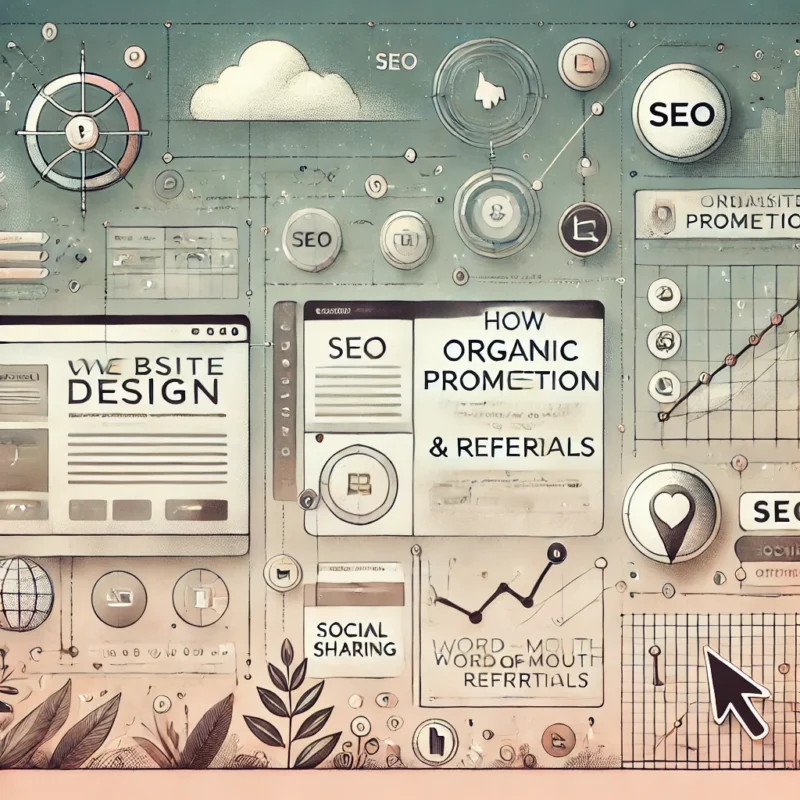How Website Design Contributes to Organic Promotion and Referrals
In the digital marketplace, your website is more than just a platform to showcase your graphic elements and clipart—it’s a powerful marketing tool that can significantly impact your organic reach and referral traffic. Thoughtful website design goes beyond aesthetics; it creates an environment that encourages sharing, improves search engine visibility, and keeps visitors coming back for more.
User Experience: The Foundation of Referral Traffic
When visitors have a positive experience on your site, they’re more likely to share it with others. A well-designed website with intuitive navigation, fast loading times, and mobile responsiveness creates the kind of experience users want to recommend.
Consider these design elements that enhance user experience:
- Clear, logical menu structures that make finding products easy
- Simplified checkout processes that reduce abandonment
- Responsive design that works seamlessly across all devices
- Strategic white space that improves readability and focus
Remember that every friction point in your design potentially costs you a referral. When a customer can easily find, preview, and download your graphic elements without frustration, they’re more likely to mention your site to colleagues or friends in need of similar resources.
SEO-Friendly Design Principles
Search engines favor websites that provide excellent user experiences. These design elements directly impact your SEO performance:
Site Speed
Page loading time is a critical ranking factor. Optimize your graphic previews with properly sized images, use lazy loading where appropriate, and ensure your hosting can handle your traffic needs. Every second saved in loading time can improve both your search rankings and conversion rates.
Clean Code Structure
Well-structured HTML with proper heading hierarchies (H1, H2, H3) and semantic markup helps search engines understand your content. This organization allows search engines to properly index your product pages and blog posts, improving organic visibility.
Mobile-First Approach
Google primarily uses the mobile version of content for indexing and ranking. A mobile-responsive design isn’t just good for users—it’s essential for search visibility. Ensure your product galleries and preview functionality work flawlessly on smaller screens.
Content Presentation That Encourages Sharing
How you present your graphic elements and educational content significantly impacts shareability:
Visual Hierarchy
Guide users’ attention to your most valuable content through size, color, and placement. When visitors can quickly identify high-quality graphic elements or insightful blog posts, they’re more likely to share these discoveries.
Social Sharing Integration
Strategically placed social sharing buttons make it easy for visitors to share your products or content. Consider implementing:
- Pinterest-friendly pins for your graphic elements
- “Click to tweet” options for valuable design tips
- Portfolio-style galleries that showcase your work beautifully
Showcase Real-World Applications
Include examples of how your graphic elements look when implemented in various projects. This helps potential customers envision using your products and provides shareable inspiration.
Trust Signals That Amplify Referrals
Your website design should incorporate elements that build trust and credibility:
- Testimonials from satisfied customers
- Clear display of security badges and payment options
- Transparent pricing and licensing information
- Professional portfolio showcasing your best work
When visitors trust your site, they’re more comfortable referring colleagues to it. Each trust signal reinforces the perception that your graphic elements are worth recommending.
Content Strategy Within Your Design
Your website’s design should support a content strategy that attracts organic traffic:
- Featured blog posts that address common design challenges
- Resource sections with tutorials on using your graphic elements
- Regular updates that signal to search engines your site is active
- Strategic internal linking that guides visitors through related content
By integrating valuable content within an intuitive design framework, you create multiple entry points for organic traffic while providing resources that users want to share.
The Feedback Loop: Design That Learns
Incorporate design elements that help you gather insights:
- Heatmap tracking to see where visitors focus their attention
- User feedback forms strategically placed throughout the site
- A/B testing capabilities for different layout options
- Analytics integration for monitoring traffic sources
Use these insights to continuously refine your design, focusing on elements that generate the most organic traffic and referrals.
Conclusion
Your website design isn’t just about showcasing your graphic elements attractively—it’s a critical component of your organic promotion strategy. By focusing on user experience, SEO-friendly design principles, shareable content presentation, and trust signals, you create a platform that naturally attracts visitors and encourages referrals.
Remember that the most effective designs balance aesthetics with functionality, creating an environment where your graphic elements can shine while the underlying structure works hard to improve your visibility. Invest in thoughtful design now, and watch your organic traffic and referrals grow over time.


DON’T MISS OUT. SUBSCRIBE TO OUR NEWSLETTER.
Get notified on sales and get exclusive discounts
Latest Blog posts
Corporate Trivia Events: A Guide for Planners and HR Professionals
Apr
The Psychology Behind Trivia: Why We Love Testing Our Knowledge
Mar
Educational Benefits of Trivia: How Schools and Teachers Can Use Trivia Games
Mar
The Best Tools and Software for Creating and Selling Digital Products
Mar
How to Protect Your Digital Products from Piracy and Unauthorized Sharing
Mar
Why Digital Products Are the Future of Online Shopping
Mar
Creating Social Media Graphics That Pop Using Watercolor Elements
Mar
10 Easter Printables You Can Make with Watercolor Clipart
Mar
10 Fun Themes for a Trivia Night (and Matching Trivia Games to Use!)
Mar
10 Beautiful Christmas Printables You Can Make with Watercolor Clipart
Mar